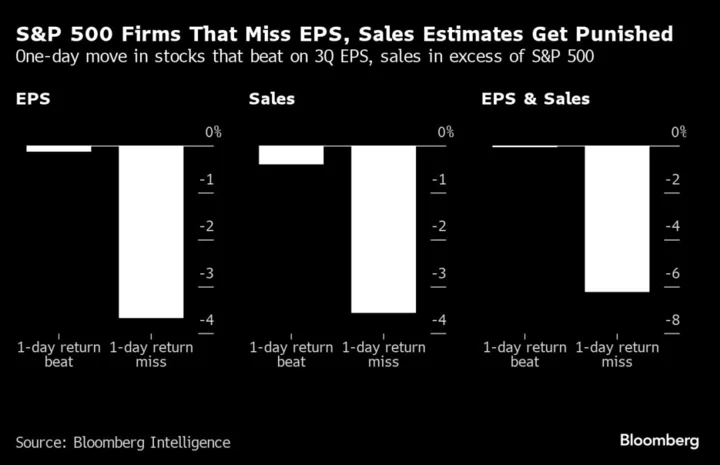The retirement of the greatest women’s tennis player is giving a new generation of competitors the chance for sporting glory — and financial riches — in the most lucrative game for female athletes.
As the US Open tournament heads to its opening matches, the women’s division has never been so unpredictable following Serena Williams’s decision to give up the sport last year. Iga Swiatek, Aryna Sabalenka, Elena Rybakina — hailing from Poland, Belarus and Kazakhstan — stand out as among the most dominant players, but the biggest tournaments have recently demonstrated just how wide open the women’s game has become.
In the past three years, more than 70% of the finals of the four major tournaments featured at least one newcomer, according to data compiled by Bloomberg. Half of the winners were lifting their Grand Slam trophies for the first time.
The US Open this year is awarding the most money of the four major global tournaments — $65 million in total — and was the first to equalize pay for men and women, highlighting the more favorable backdrop for females in tennis as sports such as soccer come under scrutiny for their disparate treatment. The Open’s location in New York City and impressive television ratings make it extra appealing to sponsors. Meanwhile, the women’s game is particularly entertaining and exciting for fans — and increasingly gamblers — because the turnover among the sport’s best athletes has made it so much less predictable than the men’s version, where just a handful of players have dominated for two decades.
“You love the variety, the unpredictability of it all, when someone comes out of nowhere,” said Tim Bunnell, senior vice president of tennis programming and acquisitions at ESPN. “It’s a great story, and lovely to tell from a media perspective.”
Among notable entrants to this year’s US Open, which begins Monday, is Ons Jabeur, the 28-year-old Tunisian who’s the first Arab player to have played in a major singles final. Then there’s Marketa Vondrousova, whose Wimbledon victory this year was the first by an unseeded woman. Her win featured a crafty style that emphasized slice and drop shots, techniques that are more accessible to the average club player than what’s seen in the men’s game, which tends to have a blistering pace that sets it apart from the typical country club scene.
There’s another trend in women’s tennis that’s adding intrigue to the game: It’s leading the charge of professional athletes competing again after maternity leave. Williams reached four grand slam singles finals after giving birth to her first daughter in 2017 — she even won that year’s Australian Open in the early stages of her pregnancy. Victoria Azarenka came back around the same time after giving birth and has been ranked inside the top 20 nearly every year since.
In the last few months, Caroline Wozniacki and Elina Svitolina have returned and are finding their past form that took each of them to top-5 rankings in recent years. And Naomi Osaka has said she’ll compete early next year after having her first child last month.
Women vs. Men
Until recently, women’s professional tennis also seemed just as dominated by superstars as the men. Between 1999 and 2019 — spanning the first and last Grand Slam singles finals for Serena Williams — other players including her sister, Venus, and legends like Martina Hingis, Lindsay Davenport, Jennifer Capriati, Justine Henin, Kim Clijsters and Maria Sharapova were also in their prime and made the winners’ circle very concentrated. In that period, which had 84 majors, 26 crowned first-time champions and more than 30 had at least one first-time finalist.
Compare that to the last 14 grand slams, going back to the 2020 Australian Open. Half were first-time champions and 10 had at least one first-time finalist.
On the men’s side, there hasn’t been much variety in the past two decades, portions of which saw Andre Agassi and Pete Sampras at the top of their games before Roger Federer, Rafael Nadal and Novak Djokovic became what’s now known as the Big Three.
There’s been more opportunities in recent years since Federer retired and as Nadal deals with injuries, clearing the way for fresh talent like Carlos Alcaraz. But Djokovic, who’s often regarded as the greatest of all time with a record 23 major titles, has yet to slow down.
Bunnell of ESPN noted that while unpredictability adds excitement, fans also like to root for superstars with long careers.
“You do want kings and queens, the consistency,” he said.
While this year’s US Open is celebrating 50 years of equal prize money for men and women, other tournaments have yet to catch up. Coco Gauff, who won the biggest title of her young career at this month’s Cincinnati Open, went home with a check for $454,500 — less than half the amount that was awarded to Djokovic, the male single’s champion. They played the same amount of matches and in the same best-of-three sets format.
Karolina Muchova, who achieved a career-high No. 10 ranking after losing to Gauff, took home even less.
“For a long time, men's tennis was considered more attractive, but lately it seems to me that women's tennis has become more fun, more unpredictable,” Muchova was quoted as saying. “The stadiums are starting to fill up.”
In the broader world of sports, female tennis stars are among the best compensated in the world. Of the top 10 highest-paid female athletes last year, seven of them were tennis players, according to Forbes.
And it’s not only the players who are making more money — gamblers stand to, as well. Bets and handles, or the amount of money wagered, have increased more for Women’s Tennis Association events than Association of Tennis Professionals events, the men’s tour, according to data from online-gambling company FanDuel, which recently renewed its multi-year agreement with the WTA as an authorized gaming operator.
“Serena Williams was the Tiger Woods for the sport of tennis — she rarely lost and was embraced by new tennis fans,” said Johnny Avello, the director of race and sports operations for DraftKings, a rival to FanDuel. “She, on the women’s side, and Djokovic, Nadal and Federer, on the men’s side, have changed the game forever. That includes gambling and how the game is played."









